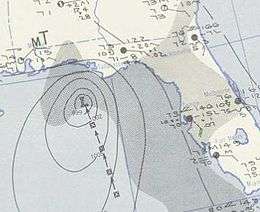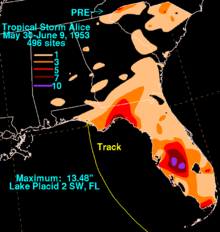Tropical Storm Alice (1953)
Tropical Storm Alice was the first tropical cyclone in the Atlantic Ocean to receive a female name. It was a rare off-season tropical cyclone that hit Central America, Cuba, and Florida in late May to early June 1953. Alice formed on May 25 in the western Caribbean, and executed a large loop over Central America. It passed over western Cuba, causing heavy rainfall and possibly several casualties from drowning. It then executed another loop in the Gulf of Mexico, reached a peak intensity of 70 mph (110 km/h), and weakened before hitting the Florida panhandle on June 6. Although heavy rainfall occurred in Florida, there was little damage.
| Tropical Storm (SSHWS/NWS) | |
 Surface weather analysis of Alice on June 6 | |
| Formed | May 25, 1953 |
|---|---|
| Dissipated | June 6, 1953 |
| Highest winds | 1-minute sustained: 70 mph (110 km/h) |
| Lowest pressure | 994 mbar (hPa); 29.35 inHg |
| Fatalities | Several unconfirmed |
| Damage | Minimal |
| Areas affected | Central America, Cuba, Florida, Alabama |
| Part of the 1953 Atlantic hurricane season | |
Meteorological history

In May and June 1953, an unusually long-lasting upper-level low persisted across Mexico and Central America. On May 25, a weak warm-core surface circulation developed east of Nicaragua. It moved around the upper-level low, bringing it to the northwest and later looping to the south through Honduras and Central America. The system weakened over land, but it re-intensified over the western Caribbean Sea, moving over western Cuba as a 50 mph (80 km/h) tropical storm on May 31.[1] Advisories for Alice did not begin until June 1, when the storm entered the Gulf of Mexico.[2]
Around the time of the cyclone's naming, reconnaissance aircraft reported winds of around 65 mph (105 km/h), and subsequently Alice executed another loop off the northwest coast of Cuba.[1] Alice weakened quickly to minimal tropical storm status, due to interaction with a cold front off Florida.[3] It deteriorated so much that advisories were discontinued, with Miami Weather Bureau meteorologist James George remarking that "no danger [existed there] whatsoever."[4] After again passing near the Cuban coast, Alice turned to the northwest and began re-strengthening. On June 5, reconnaissance aircraft estimated 70 to 75 mph (110 to 120 km/h) winds in brief squalls northeast of the center, along with a pressure of 997 hectopascals (29.4 inHg); this would be its peak intensity. The storm again weakened as it approached the Florida peninsula, and Alice made landfall just west of Panama City Beach on June 6 as a minimal tropical storm. It dissipated shortly thereafter.[1]
Impact and records

While the storm was in the vicinity of western Cuba, it produced heavy rainfall, which broke a nine-month drought. The rainfall caused flooding, and there were unconfirmed reports of several deaths due to drowning.[1]
When advisories first began on the storm, the National Hurricane Center issued storm warnings from Key West through Tarpon Springs on the west coast of Florida; at the same time, the agency posted small craft warnings for the east coast up through Palm Beach.[2] Alice brought heavy rainfall to Florida, peaking at 13.48 inches (342 mm) in Lake Placid in the central portion of the state.[5] The rains ended a dry spell in the state.[1] Along the Florida panhandle, workers tied down planes in local Air Force and Naval bases. No evacuations were ordered, and the primary impact was in the form of light rain.[6] There were no reports of damage in the state.[1]
From 1950 to 1952, Atlantic hurricanes were named using the Joint Army/Navy Phonetic Alphabet. Before the 1953 season, officials changed the system to using female names; hence, Alice was the first in the new format.[7] Male names would not be used until 1979.[8] The name "Alice" was later reused twice in 1954 for a hurricane in June and December, as well as for a hurricane in 1973.[8]
See also
References
- Grady Norton (1953). "Hurricanes of 1953" (PDF). Miami Weather Bureau Office. National Oceanic and Atmospheric Administration. Retrieved 2010-01-05.
- Associated Press (1953-06-01). "Season's First Storm Develops in Gulf as Winds Increase Rate". The Florence Times. Google News Archive. Retrieved 2010-01-05.
- United Press International (1953-06-03). "Cold Gulf Air Cools 'Cane Alice". Sarasota Herald-Tribune. Google News Archive. Retrieved 2010-01-05.
- Staff Writer (1953-06-03). "Storm 'Alice' Fizzles in Gulf". Palm Beach Post. Google News Archive. Retrieved 2010-01-05.
- Roth, David M; Hydrometeorological Prediction Center (2012). "Tropical Cyclone Rainfall in Florida". Tropical Cyclone Rainfall Point Maxima. United States National Oceanic and Atmospheric Administration's National Weather Service. Retrieved June 23, 2012.
- United Press International (1953-06-07). "Florida Storm Buffets Beaches". Sarasota Herald-Tribune. Google News Archive. Retrieved 2010-01-05.
- United Press International (1953-06-01). "Tropical Storm Whips Cuban Coast". Reading Eagle. Google News Archive. Retrieved 2010-01-05.
- "Easy-to-Read HURDAT 1851–2008". National Hurricane Center. National Oceanic and Atmospheric Administration. 2009. Retrieved 2009-12-30.
